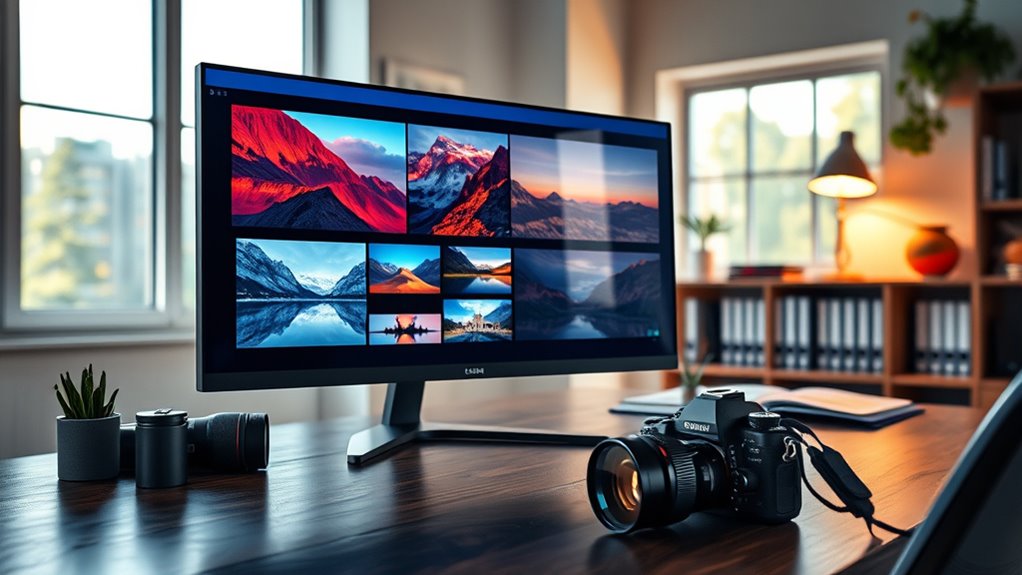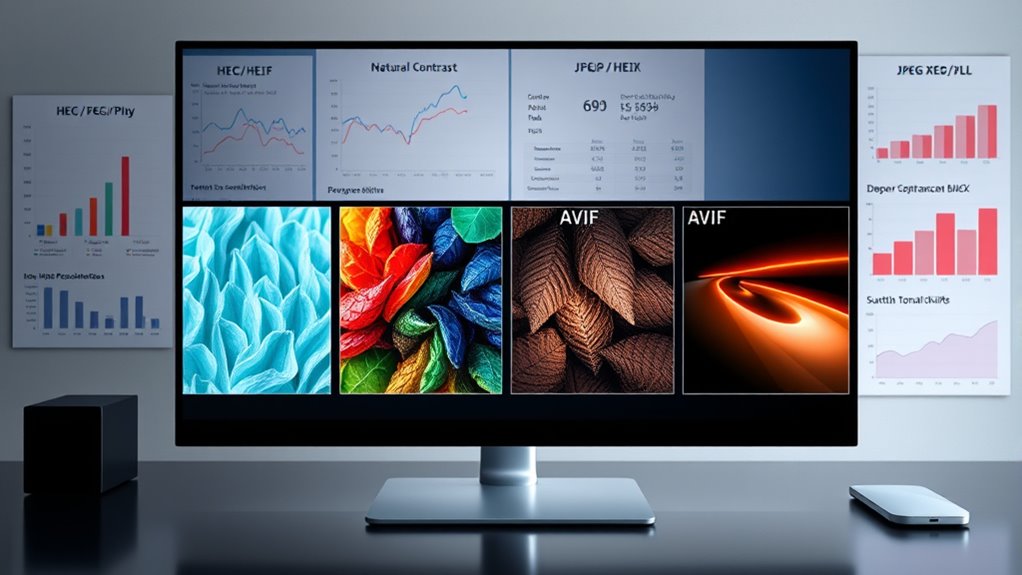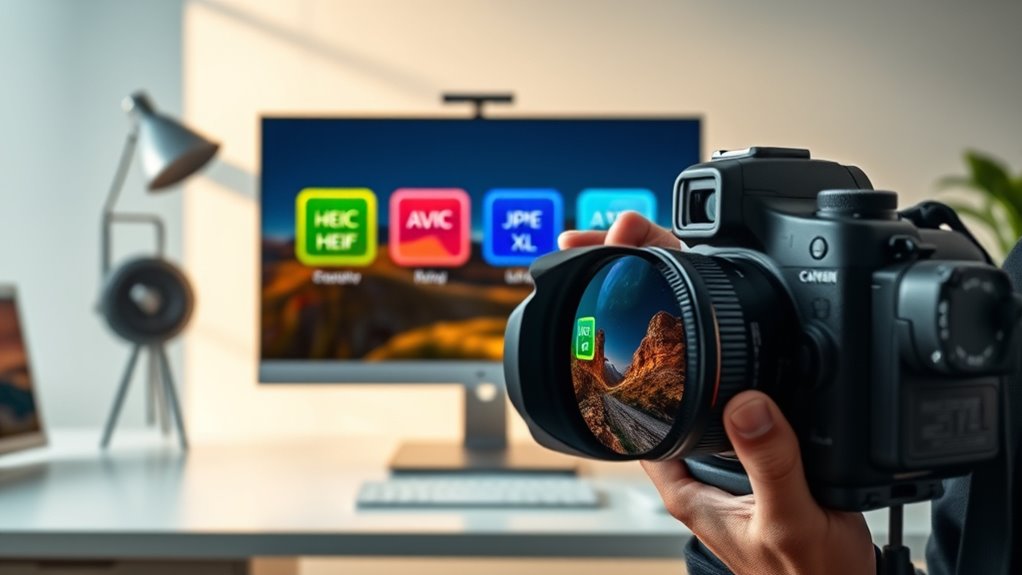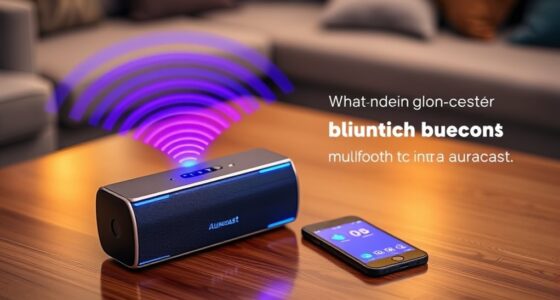By 2025, you should use AVIF for web images due to its excellent compression and broad browser support, ensuring fast loading and great quality. If you’re handling professional photos or archiving high-quality files, JPEG XL offers advanced features like high bit depths and HDR. HEIC is ideal for mobile devices and quick sharing within Apple ecosystems, while WebP serves as a reliable fallback for compatibility. To optimize each use, understanding their strengths and limitations is essential—discover more insights ahead.
Key Takeaways
- Use AVIF for web images due to its superior compression, broad browser support, and versatility across low to medium quality images.
- Opt for JPEG XL in professional workflows and archiving for high fidelity, HDR support, and efficient lossy/lossless compression.
- Choose HEIC on Apple and Android devices for quick, high-quality mobile photography, despite limited browser compatibility.
- Rely on WebP as a fallback for broad platform support when delivering images across diverse browsers and devices.
- Consider device ecosystem, image quality requirements, and support trends to select the most appropriate format for each use case.
Overview of Key Image Formats in 2025

Are you aware of how the landscape of image formats has evolved by 2025? Today, AVIF dominates web use thanks to its superior compression and broad browser support, making images load faster without sacrificing quality. JPEG XL is gaining traction for professional photography and archiving, offering advanced features like high bit depths and both lossy and lossless compression. HEIC remains popular on mobile devices, especially within Apple ecosystems, thanks to hardware acceleration, but its licensing issues limit broader adoption. WebP stays relevant as a fallback format, providing compatibility across platforms with decent compression. Each format serves specific needs: AVIF for web, JPEG XL for high-quality storage, HEIC for mobile photography, and WebP for broad compatibility. Recognizing the importance of efficient image formats is essential for optimizing visual content across devices and platforms. Additionally, staying informed about emerging formats and their compatibility can help content creators select the most effective formats for their specific use cases. Understanding advancements in compression technology can further enhance content delivery and user experience.
Technical Capabilities and Performance Benchmarks

By 2025, the technical capabilities and performance benchmarks of image formats have become essential in choosing the right format for specific applications. You’ll find JPEG XL offers up to 55% smaller files than JPEG with better quality and outperforms AVIF in some cases, especially for high-quality needs. AVIF excels at compressing low to medium-quality images with smaller sizes, ideal for web use. HEIC achieves about 50% smaller files than JPEG at similar quality but has limited support outside Apple devices. JPEG XL supports high bit depths (up to 32 bits), HDR, and fast encoding, making it suitable for professional workflows. AVIF and HEIC support HDR and transparency, but AVIF offers faster browser decoding. Decoding and encoding speeds vary: JPEG XL is faster, while AVIF benefits from hardware acceleration and efficient compression techniques. Additionally, compatibility with devices and software plays a crucial role in selecting the most appropriate format for various uses. As adoption increases, standardization efforts will further influence format support and integration across platforms. Continued industry collaboration is vital to ensure seamless adoption and interoperability of emerging standards in the future. Emerging standards are also likely to influence future compatibility and performance benchmarks, ensuring formats keep pace with technological advancements.
Browser and Platform Support Landscape

In 2025, the support landscape for image formats across browsers and platforms has become a key factor in determining their practical use. AVIF leads with full support in Chrome, Firefox, Edge, and Safari, making it the top choice for web delivery. JPEG XL has limited browser support (~10%), restricting its deployment but showing potential for niche applications. HEIC remains dominant on Apple devices and Android smartphones but lacks broad browser compatibility, requiring conversions for web use. WebP enjoys widespread support across browsers and platforms, often serving as a fallback. The table below summarizes current support:
| Format | Chrome | Firefox | Safari | Edge |
|---|---|---|---|---|
| AVIF | Yes | Yes | Yes | Yes |
| JPEG XL | No | No | No | No |
| HEIC | Limited | Limited | Yes | Limited |
| WebP | Yes | Yes | Yes | Yes |
Support for emerging formats like JPEG XL is expected to grow as adoption increases. Additionally, platform-specific support can influence format choice depending on the target audience, especially considering the widespread use of HEIC on Apple devices. Staying informed about browser support trends is essential for making optimal format decisions in 2025.
Practical Recommendations for Different Use Cases

Choosing the right image format depends on your specific use case and priorities. For web delivery, AVIF offers excellent compression and broad browser support, making it ideal for social media and online content. If you’re focused on professional photography, archiving, or workflows needing both high quality and advanced features, JPEG XL is your best choice due to its high fidelity, lossless options, and backward compatibility. For smartphone photography and quick sharing within Apple or Android ecosystems, HEIC provides efficient encoding and seamless integration. When compatibility across a wide range of browsers and platforms is essential, WebP remains a reliable fallback. Always consider your target devices, desired image quality, compression efficiency, and platform support to select the most suitable format for each project. Understanding the best anime movies and animated films that touch hearts can also inspire visually compelling content that resonates with your audience. Additionally, evaluating the biodiversity of your images can enhance their ecological relevance and storytelling impact. Selecting an optimal format can also improve image quality while reducing file sizes, which is crucial for delivering fast-loading web pages. Moreover, being aware of the home improvement context can help tailor visual content that aligns with your overall message or branding. Recognizing the importance of file compatibility ensures your images work seamlessly across different devices and software environments.
Frequently Asked Questions
How Do Licensing Costs Impact Adoption of HEIC and JPEG XL?
Licensing costs considerably impact your adoption of HEIC and JPEG XL. HEIC, based on patented HEVC, involves licensing fees, which can limit its use in commercial projects and increase costs. JPEG XL, being royalty-free, offers a cost-effective alternative, encouraging wider adoption. If you want to avoid licensing expenses and promote open standards, JPEG XL becomes more appealing, especially for professional and archival applications.
Which Format Offers the Best Long-Term Archival Stability?
Imagine you’re archiving a large collection of high-quality photographs for future access. JPEG XL offers the best long-term archival stability because it supports both lossy and lossless compression, includes generation loss resilience, and maintains backward compatibility with JPEG. This means your images stay high quality over time, even after multiple edits, making JPEG XL ideal for long-term storage. Its open, royalty-free nature also encourages ongoing support and development.
Can JPEG XL Replace Traditional JPEG in Existing Workflows?
You can replace traditional JPEGs with JPEG XL in your workflows because it offers better compression, supports lossless and lossy formats, and is backward compatible with JPEG. Its faster encoding speeds and advanced features like transparency and animation make it suitable for professional photography and archival purposes. However, keep in mind that browser support is still limited, so you might need fallback formats for web delivery.
What Hardware Requirements Are Needed for Efficient AVIF Encoding?
Hardware hurdles hinder efficient AVIF encoding. You’ll need a powerful processor, preferably multicore, to manage the demanding data crunching. A dedicated GPU accelerates encoding, making the process smoother and faster. Sufficient RAM ensures seamless handling of large files. For peak performance, hardware supporting hardware-accelerated encoding, like modern CPUs and GPUs, is essential, transforming the technical terrain into a tractable task, turning tedious tasks into swift, smooth successes.
How Do Image Formats Handle Accessibility and Color Management?
You handle accessibility and color management by choosing formats supporting extensive color depths, HDR, and transparency, like JPEG XL and AVIF. These formats preserve color fidelity and smooth gradients, making images more accessible for color-critical tasks. You also guarantee compatibility with color profiles and metadata, allowing consistent display across devices. Using formats with built-in HDR and wide gamut support helps improve visibility and understanding for users with visual impairments.
Conclusion
Choosing the right image format is like picking the perfect tool for a job—you want efficiency without sacrificing quality. Just last year, I switched my website to AVIF, and load times dropped by 30%, making visitors happier. As you navigate 2025’s options like HEIC, AVIF, or JPEG XL, remember each has strengths for different needs. Make informed choices, and your images will shine—fast, sharp, and ready for any platform.









